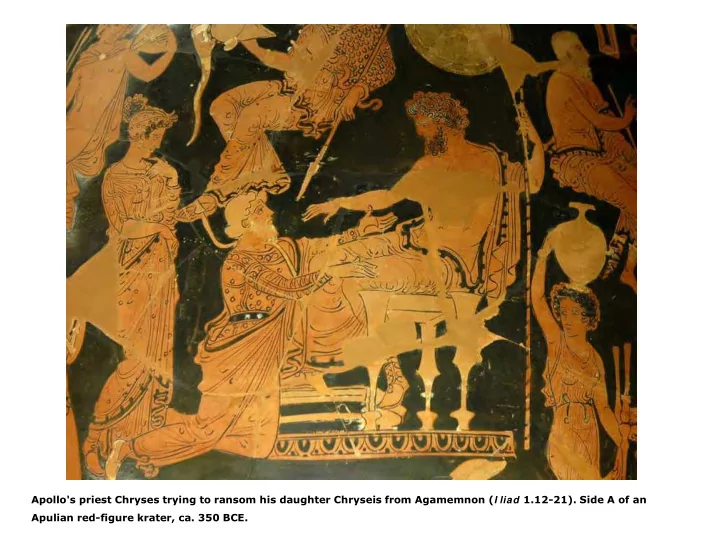

Apollo's priest Chryses trying to ransom his daughter Chryseis from Agamemnon ( I liad 1.12-21). Side A of an Apulian red-figure krater, ca. 350 BCE.
Achilles and Ajax playing dice. Their names are inscribed, and they call out numbers, three ( tria ) and four ( tesara) . Potter Exekias' signature (ΕΧΣΕΚΙΑΣ ΕΠΟΙΕΣΕ, "Exekias made me") appears on the upper left. Detail from black- figure vase, ca. 540 BCE.
Achilles (L) and Ajax (R) playing dice, identified by inscriptions. Black-figure Attic lekythos, ca. 500 BCE.
Diomedes (L) exchanging weapons with Glaucus (R), captain of the Lycian army ( I liad 6.230-36). Attic red-figure pelike, ca. 420 BCE.
Diomedes attacks Aeneas with a spear. Aeneas faints and is rescued by Aphrodite (compare I liad 5.297-317, where Diomedes' weapon is a large stone). Detail of an Attic red-figure krater, ca. 470 BCE.
The embassy to Achilles ( I liad 9): Phoenix and Odysseus (L) in front of Achilles and Patroclus (R). Attic red-figure hydria, ca. 480 BCE.
Sarpedon's body carried by Hypnos and Thanatos (Sleep and Death), while Hermes watches ( I liad 16.667-83: Zeus sends Phoebus Apollo to reclaim Sarpedon's body and deliver it to Sleep and Death). Side A of the Euphronios krater, Attic red-figure krater signed by Euxitheos (potter) and Euphronios (painter), ca. 515 BCE.
Athenian youths arming themselves. Side B of the Euphronios krater, an Attic red-figure krater signed by Euxitheos (potter) and Euphronios (painter), ca. 515 BCE.
Achilles tending Patroclus, wounded by an arrow, identified by inscriptions on the upper part of the vase. Detail of an Attic red-figure kylix, ca. 500 BCE.
Fighting for Patroclus' corpse. Menelaus has killed Euphorbus; Hector tries to reclaim the body (see I liad 17.1-81). Polychromatic East Greek plate, ca. 600 BCE.
Thetis gives Achilles his new armor forged by Hephaestus ( I liad 19.12-18). Detail of an Attic black-figure hydria, ca. 540 BCE.
Funeral games for Patroclus ( I liad 23). Fragment of a dinos, by Sophilos, ca. 580 BCE.
The ransom of Hector ( I liad 24). Priam and attendants bearing gifts approach from the left. Hector's corpse lies under Achilles' couch, and Achilles is depicted as drinking wine on the couch. He is telling a cup-bearer to bring him more wine. Attic red-figure skyphos by Brygos Painter, ca. 485 BCE.
Achilles kills Penthesilea, an Amazon warrior (see Quintus of Smyrna, Posthom erica 1.573-810). Detail from an Athenian black-figure amphora by Exekias, ca. 540 BCE. Exekias's signature (ΕΧΣΕΚΙΑΣ ΕΠΟΙΕΣΕ, "Exekias made me") appears on the upper left.
Achilles kills Penthesilea. Attic red-figure kylix, ca. 460 BCE.
Achilles kills Penthesilea. A plate, ca. 450 BCE.
Ajax carrying the corpse of Achilles (Quintus, Posthom erica 3.217-95). Attic black-figure lekythos, ca. 510 BCE.
Dispute between Ajax and Odysseus for Achilles' armor (Quintus, Posthom erica Book 5; Sophocles, Ajax ). Attic black-figure oinochoe, ca. 520 BCE.
Telamonian Ajax preparing his suicide (Quintus, Posthom erica 5.451-99). Reproduced from a black-figure amphora depiction by Exekias (530-525 BCE).
The suicide of Telamonian Ajax. Detail from Etrurian red-figured krater, ca. 400 BCE.
Diomedes, Phoenix, Nestor, Agamemnon, Teucer, and "lesser" Ajax, son of Oileus, find the dead body of Telamonian Ajax. Corinthian black-figure fragment attributed to Cavalcade Painter, ca. 580 BCE.
The Mykonos Vase. Archaic period (ca. 670 BC). The main body contains several small scenes depicting the slaughter of women and children by Achaean soldiers; the upper portion, between the handles (above), depicts the Trojan horse and the men emerging from it. Uncovered in 1961 in a field in Mykonos by a local farmer digging a well.
Priam killed at his altar by Achilles' son Neoptolemus ( Aeneid 2.581-652). Detail of an Attic black-figure amphora, ca. 520 BCE.
Menelaus finds Helen and intends to kill her; but, dazzled by her beauty, he drops his sword. A flying Eros and Aphrodite (on the left) watch the scene (Quintus, Posthom erica 13.385-415). Detail of an Attic red-figure krater, ca. 450 BCE.
Aeneas' flight from Troy ( Aeneid 2. 833-57). Federico Barocci, 1598.
Odysseus and his men blind the Cyclops Polyphemus ( Odyssey 9). Fragment of an Argive bowl, mid-7th century BCE.
Odysseus and his men blind the Cyclops Polyphemus. Detail of Eleusis amphora, proto-Attic work, ca. 650 BCE.
Odysseus blinds the sleeping Polyphemus. Black-figure vessel for wine, ca. 500 BCE.
Odysseus and the Sirens ( Odyssey 12). Detail from an Attic red-figure stamnos, ca. 470 BCE.
Eurycleia, bathing Odysseus' feet, recognizes him by the scar on his thigh ( Odyssey 19.386-475). Side A of a red- figure skyphos by Penelope Painter, ca. 440 BCE.
Odysseus, having strung the bow, kills the suitors in his palace ( Odyssey 22.1-41). Two sides of a red-figure Attic cup, ca. 440 BCE. On side A, Odysseus draws his bow as two serving girls look on; on side B the cowering suitors try to defend themselves.
Dionysos and his thiasos (ecstatic followers). Side A from an Attic red-figure krater, ca. 500 BCE.
The seventh century poet Mimnermus attributes the murder of Ismene, sister of Antigone, to Tydeus (father of Diomedes). No other classical writer mentions the story. Detail of a 6th century Corinthian black-figure amphora.
Recommend
More recommend